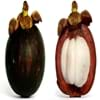Health Benefits
Good for diabetics, Improves well-being, Miraculin/miracle fruit makes sour things taste sweet
Cancer prevention, Controls blood pressure, Heart care, Increase in haemoglobin, Prevents constipation, Prevents macular degeneration, Reduces nervous tension
General Benefits
Has taste modifying effect
Controls blood pressure, Helps in weight loss, Maintains healthy cholesterol level, Strengthens bones
Skin Benefits
NA
Brightens and lightens complexion, Hydrates skin, Skin rejuvenation, Treatment of acne
Hair Benefits
NA
Good conditioner, Regulates hair growth, Softening mask
Allergy Symptoms
Itching, Skin rash
Abdominal pains, Anaphylaxis, Coughing, Headaches, Hives, Itching, Nasal congestion, Skin rash, Sneezing, Sore throat, Swelling of hands
Side Effects
Changes taste of food eaten after this fruit, Coagulation
Allergic reaction, Skin rash, Possibly unsafe during pregnancy
Best Time to Eat
As a snack in the late afternoon, Eat the fresh ones, avoid mixing with any other foods, don't eat after meal., Morning time (before lunch)
Best if taken as a breakfast (or empty stomach), Don't consume at night and before bed, Morning time (before lunch)
Protein to Carb Ratio
Not Available
Vitamin A (Retinol)
Not Available
Vitamin B1 (Thiamin)
Not Available
Vitamin B2 (Riboflavin)
Not Available
Vitamin B3 (Niacin)
Not Available
Vitamin B5 (Pantothenic Acid)
Not Available
Vitamin B6 (Pyridoxin)
Not Available
Vitamin B9 (Folic acid)
Not Available
Vitamin C (Ascorbic Acid)
Vitamin K (Phyllochinone)
Not Available
Lutein+Zeaxanthin
Not Available
Phytosterol
Not Available
Water Content
Not Available
Calories in Fresh Fruit with Peel
Not Available
Calories in Fresh Fruit without Peel
Not Available
Not Available
Calories in Frozen Form
Not Available
Calories in Dried Form
Not Available
Calories in Canned Form
Not Available
Calories in Juice
Not Available
Calories in Jam
Not Available
Calories in Pie
Not Available
Season
Monsoon
Summer, Winter
Varieties
Gymnema Sylvestre and Thaumatococcus Daniellii
Abyad, Adriatic, Alma, Atreano, Bataglia, Black Bethlehem, Black Madeira, Black Mission, Brown Turkey, Sierra, Calimyrna, Kadota, Deanna, Figoin and Hardy Chicago Fig
Color
Dark red
Green, Purple, Red
Inside Color
Greyish-white
Pink
Origin
West Africa
Western Asia
Soil Type
Well-drained
Clay, Limestone, Loam, Sandy
Climatic Conditions
Rainfall
Dry, Warm
Facts about
- The name 'Miracle' because of the magical experience you get after eating it.
- When you have lemon after eating this fruit, it tastes sweet as if it is added with sugar.
- It is also used as natural sweetener.
- Fig tree is considered as a symbol of abundance, fertility and sweetness.
- The fig is made up of 55% of natural sugar so they are the sweetest fruits.
- Figs are used as a fat substitute in recipes.
Other Countries
NA
Albania, Algeria, Brazil, Egypt, Iran, Morocco, Syria, Tunisia, United States of America
Top Importer
Not Available
France
Top Exporter
United States of America
Turkey
Botanical Name
Synsepalum Dulcificum
Ficus carica
Synonym
Miracle Berry, Miraculous Berry and Sweet Berry
Not Available
Subkingdom
Tracheobionta
Tracheobionta
Division
NA
Magnoliophyta
Subclass
Asteridae
Alismidae
Family
Sapotaceae
Moraceae
Species
S. dulcificum
Ficus carica
Generic Group
Not Available
Mulberry
Difference Between Miracle fruit and Fig
We might think that Miracle fruit and Fig are similar with respect to nutritional value and health benefits. But the nutrient content of both fruits is different. Miracle fruit and Fig Facts such as their taste, shape, color, and size are also distinct. The difference between Miracle fruit and Fig is explained here.
The amount of calories in 100 gm of fresh Miracle fruit and Fig with peel is Not Available and 74.00 kcal and the amount of calories without peel is Not Available and Not Available respectively. Thus, Miracle fruit and Fig belong to Low Calorie Fruits and Low Calorie Fruits category.These fruits might or might not differ with respect to their scientific classification. The order of Miracle fruit and Fig is Ericales and Rosales respectively. Miracle fruit belongs to Sapotaceae family and Fig belongs to Moraceae family. Miracle fruit belongs to Synsepalum genus of S. dulcificum species and Fig belongs to Ficus genus of Ficus carica species. Beings plants, both fruits belong to Plantae Kingdom.









